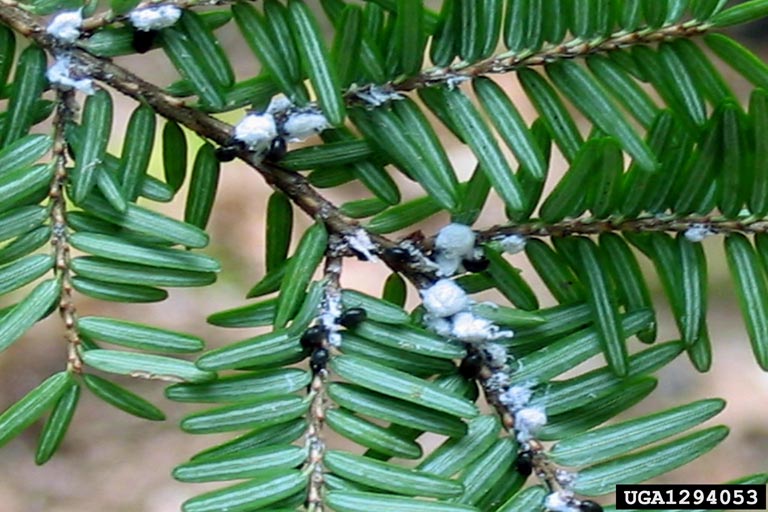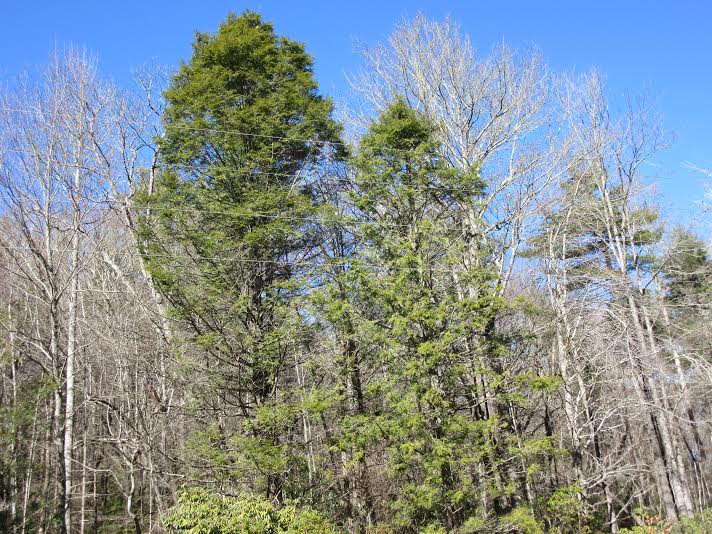Hemlock Woolly Adelgid Treatment for Private Landowners
Hemlock Woolly Adelgid Treatment for Private Landowners:
A private landowner seeking treatment options for hemlocks with hemlock woolly adelgid (HWA) infestations faces a clear choice – between chemical and biological control options. And despite the discussion about the “expensive” one-time release of predator beetles, the financial cost of repeated chemical treatments will always be much greater (and the coverage always less extensive) than establishing biological control of your “HWA invaders”. And then there is the issue of introducing synthetic, neurotoxic chemicals into your residential environment to consider.
The Basic Choice in Hemlock Woolly Adelgid Control:
Short-Term, Chemical Insecticide Applications to Selected Individual Hemlocks
versus
Long-Term, Natural, Biological Treatment for all Hemlocks in an Area
Does it make sense to invest in repeated chemical treatments for some trees, while allowing all the other hemlocks in your neighborhood to be destroyed? And what if you own a large woodland or riparian hemlock area. Do you chemically treat some hemlocks and let the others die? Or do you pay to have all the hemlocks removed and then face the problem (and expense) of how to repopulate your woodland areas so as to support the hemlock-dependent natural ecosystems ?
On the other side of the decision-tree, we have a natural treatment solution – biocontrol of hemlock woolly adelgid – that will last for the natural life-span of all the hemlocks on your and surrounding properties. Once established, it will protect all hemlocks in an area and will allow most HWA-damaged hemlocks to restore their foliage. It has no toxic properties, immediate or residual. And the recommended HWA predator, Sasajiscymnus tsugae, is a specialist insect which requires adelgids as a food source to survive and reproduce. So this USDA/APHIS approved predator represents no threat to other native insects or plants in the eastern US.
Here are some sources of information on other topics concerning hemlocks, HWA and its biological predators:
How does biological control of HWA work?
What is a commercial source for HWA predator beetles ?
How can you mobilize individuals and community groups to protect and restore hemlocks?
How, when and where was HWA introduced to the eastern US?
How can a tiny beetle protect giant hemlocks from hemlock woolly adelgid?
Biological control of HWA is a simple numbers game, introducing a biological agent (in this case a predator beetle) that will reduce the pest population to a level that does not harm the host. In the case of eastern hemlocks, the pest is the Hemlock Woolly Adelgid (Adelges tsugae) – an organism accidentally introduced from Southern Japan over a century ago. And its native predator beetle from southern Japan is Sasajiscymnus tsugae (St), which was laboratory tested and approved by USDA for HWA control release over 20 years ago.
St predators respond to a large HWA concentration by eating many HWA (adults, eggs & larvae) and by laying multiple eggs per day. And the predator larvae that emerge from these eggs consume many more HWA (adults, eggs & larvae) as they grow. They then pupate into adult beetles and begin another round of feeding and reproduction. These consecutive predator reproductive cycles, which encompass both Spring and Summer HWA cycles, produce an exponential increase in Sasajiscymnus tsugae predator beetle populations and a corresponding dramatic decrease in HWA population densities.
Above are a group of Sasajiscymnus tsugae beetles that have been introduced to a HWA-infested site in the Smokies. Each hemlock woolly adelgid ovisac contains an adult (female) and an accumulation of eggs. As shown, these voracious little predator beetles will tear open an HWA ovisac and consume all the contents before moving on to the next. But some ovisacs may be left for the “kids” – the beetle larvae hatching from eggs that the beetles deposit wherever HWA is found. These larvae are even more voracious than their parents and need an HWA food supply to develop and mature. This is why HWA ovisacs in beetle release areas should not be poisoned with neurotoxic chemicals.
Despite the widespread destruction of wild hemlocks that we see around us, the hemlock woolly adelgid is not a particularly dangerous biological organism! The damage that we see today is due to long-term mismanagement of an insect that was introduced through the horticultural trade (around 1915). The uncontrolled HWA population growth over an 80 year period, (40 of which under direct USDA “management”) has produced a destructive biological “avalanche” that has swept over our native eastern hemlocks. There is no chemical option for eradication of HWA in the long term. Instead the long term solution is simple HWA population control using a biological agent Sasajiscymnus tsugae, whose ecological role is to consume hemlock woolly adelgid.
How can you contribute to biological control of Hemlock Woolly Adelgid?
Those who own property in areas with HWA-infested hemlocks have the option of purchasing HWA predator beetles to establish self-sustaining predator colonies on their own property. Unlike chemical treatments, biological treatments with Sasi predator beetles are not restricted to individual trees. They will spread to adjoining trees and areas, establishing protection for an entire hemlock area. So just release the beetles where there is a good HWA food supply, and the beetles will take care of the rest. See the Community-based control page for more information on individual and group predator beetle release strategies and methods.
But even if you don’t have hemlocks on your own property, there are many ways that you can contribute to saving our native hemlocks and hemlock-dependent ecosystems. Think of all the local parks and wild places that have at-risk hemlocks. Think of all the groups that should care about the preservation of hemlock ecosystems: birders, anglers, hikers, kids … And think of all the good that could be done if you could encourage just one group in your area to initiate a biological control project!
Imagine the feeling of passing through an area with recovering hemlocks and knowing that you had contributed to their recovery – what a rewarding environmental investment! Here is one of my 8 year release areas near Gorges State Park in North Carolina, showing the bursts of “exuberant” foliage growth that are characteristic of beetle-assisted hemlock restoration of previously damaged hemlocks.
What Can YOU Do?
You can’t initiate biological control of HWA without access to predator beetles. And the Sasajiscymnus tsugae beetle grows well in insect-rearing laboratories which can provide an ample HWA food supply. So these beetles are readily available for purchase from a predator beetle rearing lab that supports private property releases. (Disclosure: I have no ownership or financial ties with any predator beetle rearing lab).
Hemlock Restoration
The recovery of hemlocks from HWA defoliation can be a slow process. First, the beetles have to ramp up their numbers to bring the adelgids in the area under control (1-3 years). And this will allow the hemlocks to begin the process of producing new foliage to replace their lost and HWA-damaged foliage (3-5 years). But as shown above, once it starts, hemlock recovery can be breathtaking!
With severely defoliated hemlocks, you won’t see instant recovery. But you should see new crown foliage growth production on some trees in the release area by the end of the first year. Small hemlocks and those in early stages of HWA infestation should show a much more rapid recovery and help other trees return to normal hemlock foliage production.
Large, HWA-damaged hemlocks face an additional threat from the Hemlock Borer.This is a native insect that is normally benign, but can be very destructive in the presence of numerous large damaged hemlocks. Unfortunately, this insect is not affected by either chemical or biological controls for HWA. And once a hemlock borer infestation gets started in an area, most of the large hemlocks will be destroyed. So hemlock restoration in such areas will focus on the smaller surviving trees.
After your beetle release treatment the adelgids will not disappear, but they will begin to decline in number. New foliage produced at the crowns and upper branches of beetle-assisted hemlocks will usually be clear of adelgids. But branches closer to the ground (up to 10′ up the trunk) may show concentrated patches of adelgids on new growth. Just think of these as “beetle nurseries”, which will be used by the beetles to increase their population during the year. And no one would poison predator nurseries, would they?
Unfortunately, in neighborhoods with chemically dependent residents, the answer is “Yes, they would poison predator beetle nurseries where HWA are present!” But never fear, the exponential growth capabilities of the predator beetles will never be overcome by individual dispenser(s) of neurotoxic chemicals.
New hemlock foliage growth has a distinctive golden-green color. So when you see this golden-green “frosting” appearing on your hemlocks in May-June, you will recognize the progress that is underway. Just look at the trees to observe how the St predator beetles are contributing to the health of your hemlocks!


